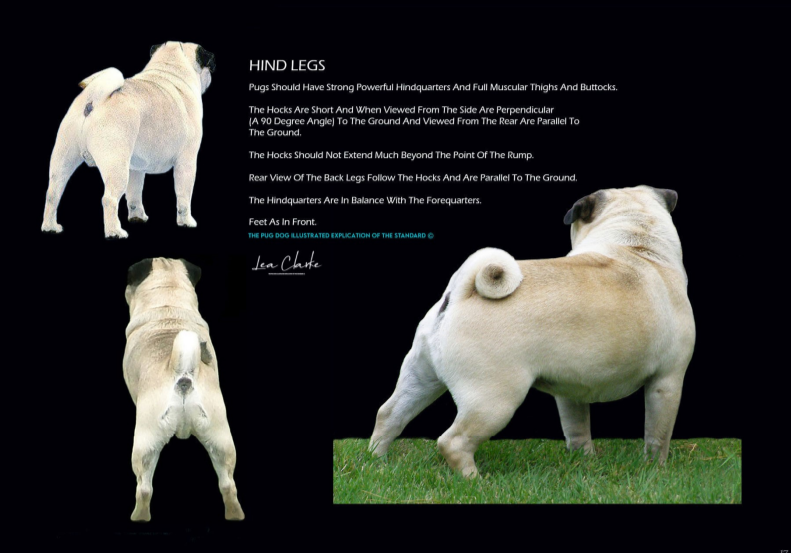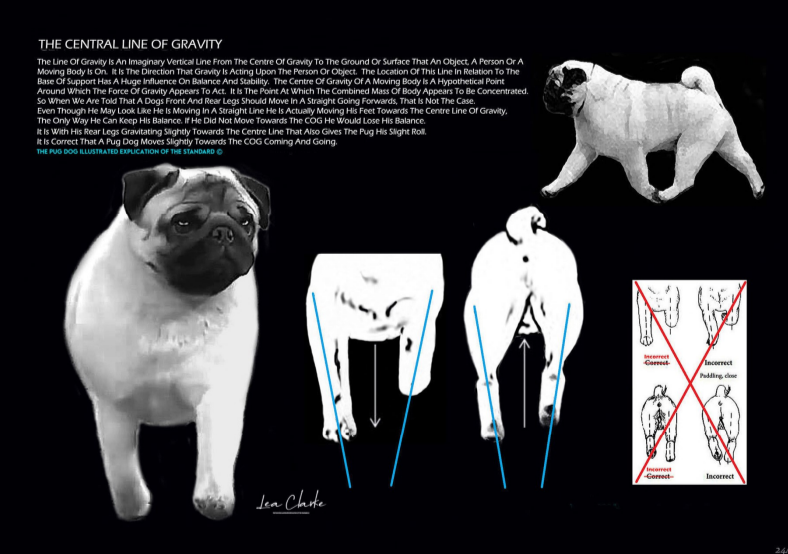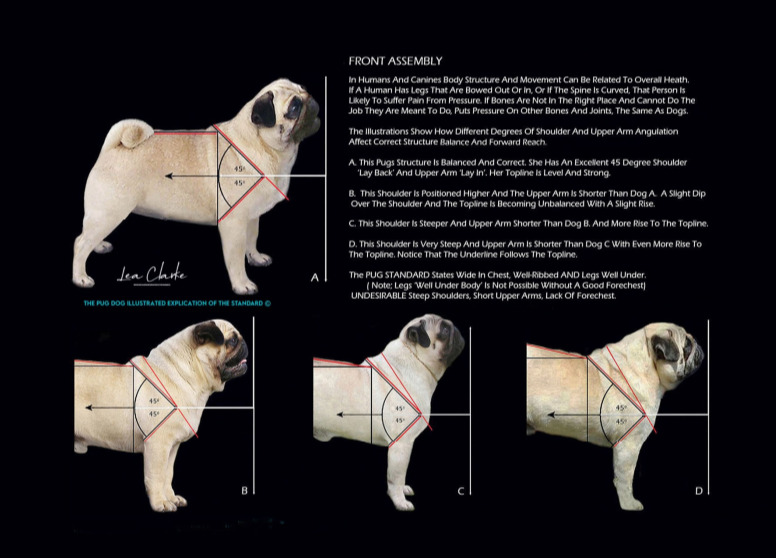|
"Pugs are not German Shepherds." Two very experienced and knowledgeable breeders recently said this when discussing a concern Jeff and I see in the pug show rings lately . . . . over angulated rears, (or working dog rear, or a European rear) or, an acute angulation of the hock joint than is normal for the breed. (I'm not an artist and the 2nd thigh is a bit too long in this drawing, but you get the gist) . . . This is unnatural and dangerously compromises the pug breed (or any breed). I recently saw a pug in the ring who was free stacked (standing naturally) but, when turning its head around to see what was behind it, its rear joints disclocated basically, and when viewing these pugs from behind when they are gaiting it's a nightmare to see with the rear pads pointing in all sorts of different directions. Dogs with over-angulation result in sickle hocks .... the dog can’t extend his hocks properly while he trots, and that will restrict the driving force of his hind legs, and therefore reduce the power in his rear. A dog with sickle hocks has a poorly synchronized gait which destroys the dog’s efficiency. Even if the dog is just "a pet" it will still impact the pleasure he has going for long walks and playing fetch. A dog with sickle hocks will have no follow-through (sort of like in a golf swing). The descriptive term, "sickle hocks" comes from the farm tool . . . . A dog with sickle hocks usually stands with is rear pasterns slightly forward in order to support weak hindquarters. When trotting, his top line will bob up and down which results in wasted energy. Instead of moving forward with power, the dog's energy goes "up and down". Also, if pugs have too much leg (length of leg) you've lost the "multum in parvo" (a lot in a little) by putting those stocky pug bodies on skinny legs. Type is lost ... it's no longer a pug. Granted, straight fronts and rears with no angles are just as bad and that has been a problem with the pug breed for a long time. This places too much stress on joints yet, for generations, people use the excuse that a pug is simply "a ladies lap dog" (quoting our good friend and longtime breeder). We have heard TOO many times in the ring, when addressing poor movement in pugs, "well, it's a pug .... it's a head breed." Hello -- it has 4 legs -- it's a dog -- and it needs to be able to walk and move easily. (Again, quoting my friend): "All dogs are head breeds" so this is a bogus excuse breeders and judges use for poor movement in pugs. So why worry about all this if you "just want a pet pug and don't care if it's a show pug"? Well, you tell us. Do you like to take long walks with your dog? Does your dog love playing fetch? Perhaps you would like your pug to try agility or another fun sport, or perhaps even just have the means to give that squirrel in the backyard a run for its money. So, while it might look flashy in the show ring with some judges now (at least when it's hand stacked and viewed from the side .... and, incidentally, not judges who understand pugs), it still remains that sickle hocks limit what the dog can do with you comfortably, and without pain. More importantly, a sound dog is less likely to “break down” from injury; the dog will experience less fatigue, be able to take those long walks with you, and show greater efficiency in work (even if it’s only to help you corral those squirrels). A sound dog stays healthier and more active throughout its life. This is why it's important to look for reputable breeders who strive to breed sound, strong, healthy pugs. When you think "I don't want a show dog", think about what you're actually saying. If you could pick out a pug to own, which one of these would you pick? Our rescue pug, Charlie Chaplin, is "fiddle front" (Chippendale above) and his rear legs are off too. The family who rehomed him to us said they bought him from a friend (or relative) who lived close by. He has no AKC registration or papers, no pedigree. He's the sweetest pug on earth but, obviously, his parents did not have correct, sound conformation. We've had to do surgery for luxating patella and we watch him 'break down' as he ages. If he had been built more like the dog in figure 1, he would be aging much better with regard to joints and movement and would still be able to have those "grand battement" kicks after every potty outside. (So dramatic). So what should proper angulation look like in a pug? What is healthy, beautiful, strong, and balanced? The hocks should NOT extend much beyond the point of the rump. Here are some photos of correct angulation from a fabulous book by Lea Clarke (highly recommended this book!) . . It is also important that the front is in balance with the rear -- which helps avoid pressure on other joints and bones. "Nature hates imbalance." Rears break down, hips - patellas. The breed standard for pugs asks for MODERATE angulation. The ideal is a moderate slope at 30 degrees where the topline is level and the tailset high. This gives a good swing forwards and backwards which allows for powerful drive. Symmetrical proportions of the parts in relation to each other . . . . Dogs with good balance and (appropriate, moderate) angulation will have a smoother stride. A well-balanced dog will look sounder, more fit, and healthier.  The Central Line of Gravity "The line of gravity is an imaginary vertical line from the center of gravity to the ground or surface that an object, a person, or a moving body is on. It is the direction that gravity is acting upon the person or object. . . . .It is with his rear legs gravitating slightly towards the center line that also gives the pug his slight roll. It is correct that a pug dog moves slightly towards the COG coming and going." "In humans and canines, body structure and movement can be related to overall health. If a human has legs that are bowed out or in, or if the spine is curved, that person is likely to suffer pain from pressure. If bones are not in the right place and cannot do the job they are meant to do, this puts pressure on other bones and joints. The same as dogs." The dog in photo a has a 45 degree shoulder lay back and upper arm lay in. Her topline is level and strong. Notice that pug in photo a meets the Pug Standard of "wide chest, well ribbed and legs well under body". Now observe how these angles affect movement . . . . Perhaps let's close this blog with a photo of Secretariat .. the perfect horse. And, to quote my breeder friend again, "it's important to remember that breed standards are largely patterned after horse standards." I'm remembering something my Grandfather was fond of saying .... "everything in moderation". This seems to apply to almost everything in life, even dog breeding! Adding extreme angulation is not the answer. To quote another amazing pug breeder (who is also an AKC judge), "The pug breed standard calls for moderate angulation. Over angulation is not correct, and the movement issue is correlated with structure not being able to compensate for it. I truly hate seeing straight stifles. But over angulation is just as bad."
0 Comments
Leave a Reply. |
AuthorAmy - Concert pianist, composer, lecturer, teacher, adjudicator, pug lover, dog trainer, soap and candle maker, PawTree Pet Pro, and co-owner Pickwick Pugs along with her husband, Dr. Jeff McLelland who is a concert organist, music director. Archives
April 2024
Categories |















 RSS Feed
RSS Feed